Bosch WFMC4301UC User Manual
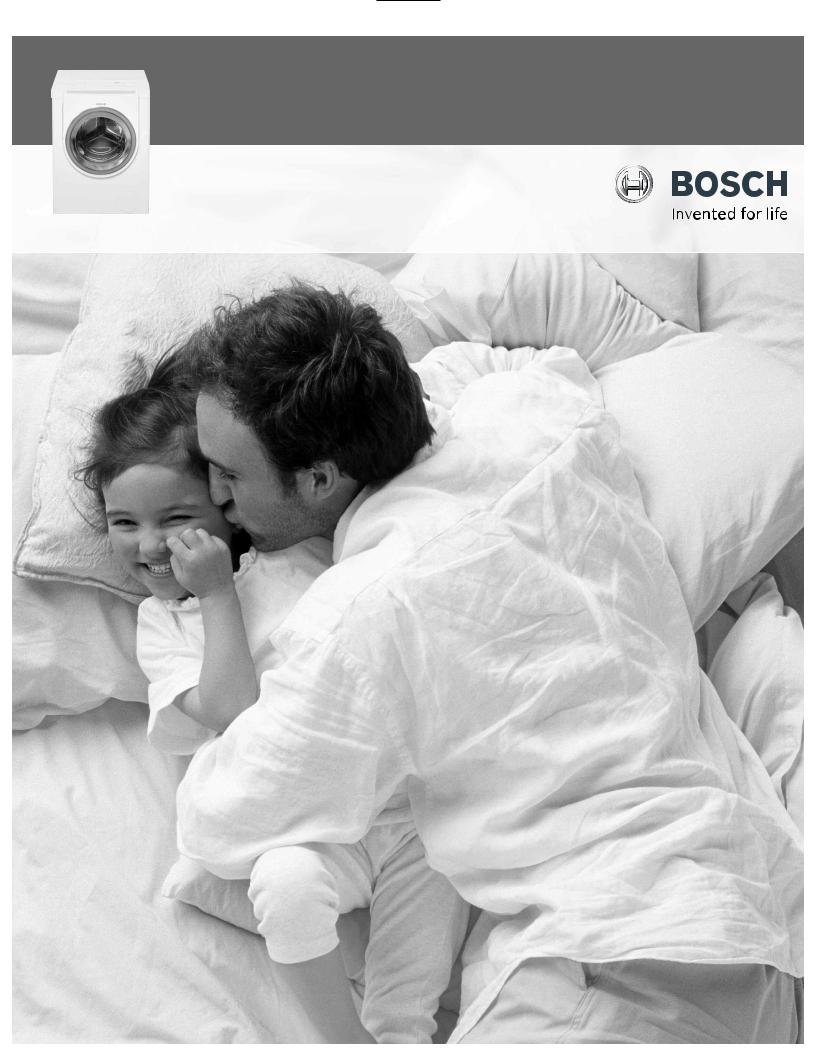
Bosch Nexxt® DLX Series Washer
Model / Modèle / Modelo:
WFMC4301UC
en |
Operating, Care and Installation Instructions |
fr |
Seche-linge: Notice d’utilsation, de maintenance et d’installation |
es |
Lavadora: Operacíon, cuidado y instrucciones para la instalación |

Table of Contents |
|
Definitions . . . . . . . . . . . . . . . . . . . . . . . . . . . . . . . . . . . . . . . . . . . . . . . . . . . . . . . . . . . . . . . . . . . . . . . . . . . . . . . . . . . . . . . . . . |
3 |
IMPORTANT SAFETY INSTRUCTIONS . . . . . . . . . . . . . . . . . . . . . . . . . . . . . . . . . . . . . . . . . . . . . . . . . . . . . . . . . . . . . . . . . |
3 |
GROUNDING INSTRUCTIONS . . . . . . . . . . . . . . . . . . . . . . . . . . . . . . . . . . . . . . . . . . . . . . . . . . . . . . . . . . . . . . . . . . . . . . . |
4 |
INSTALLATION INSTRUCTION . . . . . . . . . . . . . . . . . . . . . . . . . . . . . . . . . . . . . . . . . . . . . . . . . . . . . . . . . . . . . . . . . . . . . . . . |
5 |
Introduction . . . . . . . . . . . . . . . . . . . . . . . . . . . . . . . . . . . . . . . . . . . . . . . . . . . . . . . . . . . . . . . . . . . . . . . . . . . . . . . . . . . . . . . |
5 |
Information concerning waste disposal . . . . . . . . . . . . . . . . . . . . . . . . . . . . . . . . . . . . . . . . . . . . . . . . . . . . . . . . . . . . . . . . |
5 |
Intended use . . . . . . . . . . . . . . . . . . . . . . . . . . . . . . . . . . . . . . . . . . . . . . . . . . . . . . . . . . . . . . . . . . . . . . . . . . . . . . . . . . . . . . |
5 |
Environmental Protection / Conservation Issues . . . . . . . . . . . . . . . . . . . . . . . . . . . . . . . . . . . . . . . . . . . . . . . . . . . . . . . . . |
5 |
Factory'supplied equipment . . . . . . . . . . . . . . . . . . . . . . . . . . . . . . . . . . . . . . . . . . . . . . . . . . . . . . . . . . . . . . . . . . . . . . . . . |
5 |
Dimensions . . . . . . . . . . . . . . . . . . . . . . . . . . . . . . . . . . . . . . . . . . . . . . . . . . . . . . . . . . . . . . . . . . . . . . . . . . . . . . . . . . . . . . . |
6 |
Installation area . . . . . . . . . . . . . . . . . . . . . . . . . . . . . . . . . . . . . . . . . . . . . . . . . . . . . . . . . . . . . . . . . . . . . . . . . . . . . . . . . . . . |
6 |
Removing the transport bolts . . . . . . . . . . . . . . . . . . . . . . . . . . . . . . . . . . . . . . . . . . . . . . . . . . . . . . . . . . . . . . . . . . . . . . . . . |
6 |
Levelling procedure . . . . . . . . . . . . . . . . . . . . . . . . . . . . . . . . . . . . . . . . . . . . . . . . . . . . . . . . . . . . . . . . . . . . . . . . . . . . . . . . |
7 |
Electrical connection . . . . . . . . . . . . . . . . . . . . . . . . . . . . . . . . . . . . . . . . . . . . . . . . . . . . . . . . . . . . . . . . . . . . . . . . . . . . . . . |
7 |
Hose and cable lengths . . . . . . . . . . . . . . . . . . . . . . . . . . . . . . . . . . . . . . . . . . . . . . . . . . . . . . . . . . . . . . . . . . . . . . . . . . . . . |
8 |
Water connection . . . . . . . . . . . . . . . . . . . . . . . . . . . . . . . . . . . . . . . . . . . . . . . . . . . . . . . . . . . . . . . . . . . . . . . . . . . . . . . . . . |
9 |
Transport, such as when moving out . . . . . . . . . . . . . . . . . . . . . . . . . . . . . . . . . . . . . . . . . . . . . . . . . . . . . . . . . . . . . . . . . . |
10 |
OPERATING INSTRUCTION . . . . . . . . . . . . . . . . . . . . . . . . . . . . . . . . . . . . . . . . . . . . . . . . . . . . . . . . . . . . . . . . . . . . . . . . . . |
11 |
Your new washer . . . . . . . . . . . . . . . . . . . . . . . . . . . . . . . . . . . . . . . . . . . . . . . . . . . . . . . . . . . . . . . . . . . . . . . . . . . . . . . . . . |
11 |
Panel . . . . . . . . . . . . . . . . . . . . . . . . . . . . . . . . . . . . . . . . . . . . . . . . . . . . . . . . . . . . . . . . . . . . . . . . . . . . . . . . . . . . . . . . . . . . |
12 |
Summary of Instructions . . . . . . . . . . . . . . . . . . . . . . . . . . . . . . . . . . . . . . . . . . . . . . . . . . . . . . . . . . . . . . . . . . . . . . . . . . . . |
13 |
Before Using For the First Time . . . . . . . . . . . . . . . . . . . . . . . . . . . . . . . . . . . . . . . . . . . . . . . . . . . . . . . . . . . . . . . . . . . . . . . |
14 |
Using For the First Time . . . . . . . . . . . . . . . . . . . . . . . . . . . . . . . . . . . . . . . . . . . . . . . . . . . . . . . . . . . . . . . . . . . . . . . . . . . . . . |
14 |
First washing cycle (without laundry) . . . . . . . . . . . . . . . . . . . . . . . . . . . . . . . . . . . . . . . . . . . . . . . . . . . . . . . . . . . . . . . . . . . |
14 |
Preparing the laundry . . . . . . . . . . . . . . . . . . . . . . . . . . . . . . . . . . . . . . . . . . . . . . . . . . . . . . . . . . . . . . . . . . . . . . . . . . . . . . . |
14 |
Sorting the laundry . . . . . . . . . . . . . . . . . . . . . . . . . . . . . . . . . . . . . . . . . . . . . . . . . . . . . . . . . . . . . . . . . . . . . . . . . . . . . . . . . |
14 |
Degrees of soiling . . . . . . . . . . . . . . . . . . . . . . . . . . . . . . . . . . . . . . . . . . . . . . . . . . . . . . . . . . . . . . . . . . . . . . . . . . . . . . . . . . |
14 |
Loading the laundry . . . . . . . . . . . . . . . . . . . . . . . . . . . . . . . . . . . . . . . . . . . . . . . . . . . . . . . . . . . . . . . . . . . . . . . . . . . . . . . . |
15 |
Laundry Detergents and Additives . . . . . . . . . . . . . . . . . . . . . . . . . . . . . . . . . . . . . . . . . . . . . . . . . . . . . . . . . . . . . . . . . . . . . |
15 |
Dispensing the correct amount of detergent . . . . . . . . . . . . . . . . . . . . . . . . . . . . . . . . . . . . . . . . . . . . . . . . . . . . . . . . . . . . |
15 |
Filling laundry detergent and/or additives . . . . . . . . . . . . . . . . . . . . . . . . . . . . . . . . . . . . . . . . . . . . . . . . . . . . . . . . . . . . . . . |
16 |
Decolorizing . . . . . . . . . . . . . . . . . . . . . . . . . . . . . . . . . . . . . . . . . . . . . . . . . . . . . . . . . . . . . . . . . . . . . . . . . . . . . . . . . . . . . . . |
16 |
Programs and Functions . . . . . . . . . . . . . . . . . . . . . . . . . . . . . . . . . . . . . . . . . . . . . . . . . . . . . . . . . . . . . . . . . . . . . . . . . . . . . |
16 |
Basic programs . . . . . . . . . . . . . . . . . . . . . . . . . . . . . . . . . . . . . . . . . . . . . . . . . . . . . . . . . . . . . . . . . . . . . . . . . . . . . . . . . . . . |
16 |
Special programs . . . . . . . . . . . . . . . . . . . . . . . . . . . . . . . . . . . . . . . . . . . . . . . . . . . . . . . . . . . . . . . . . . . . . . . . . . . . . . . . . . |
16 |
Modifiers . . . . . . . . . . . . . . . . . . . . . . . . . . . . . . . . . . . . . . . . . . . . . . . . . . . . . . . . . . . . . . . . . . . . . . . . . . . . . . . . . . . . . . . . . |
17 |
Option buttons . . . . . . . . . . . . . . . . . . . . . . . . . . . . . . . . . . . . . . . . . . . . . . . . . . . . . . . . . . . . . . . . . . . . . . . . . . . . . . . . . . . . |
18 |
Acoustic Signal . . . . . . . . . . . . . . . . . . . . . . . . . . . . . . . . . . . . . . . . . . . . . . . . . . . . . . . . . . . . . . . . . . . . . . . . . . . . . . . . . . . . |
18 |
Indicator light above the •Start/Pause" button . . . . . . . . . . . . . . . . . . . . . . . . . . . . . . . . . . . . . . . . . . . . . . . . . . . . . . . . . . . |
18 |
Special features . . . . . . . . . . . . . . . . . . . . . . . . . . . . . . . . . . . . . . . . . . . . . . . . . . . . . . . . . . . . . . . . . . . . . . . . . . . . . . . . . . . . |
18 |
Washing . . . . . . . . . . . . . . . . . . . . . . . . . . . . . . . . . . . . . . . . . . . . . . . . . . . . . . . . . . . . . . . . . . . . . . . . . . . . . . . . . . . . . . . . . . . . |
19 |
During Washing . . . . . . . . . . . . . . . . . . . . . . . . . . . . . . . . . . . . . . . . . . . . . . . . . . . . . . . . . . . . . . . . . . . . . . . . . . . . . . . . . . . . . |
19 |
Changing a program . . . . . . . . . . . . . . . . . . . . . . . . . . . . . . . . . . . . . . . . . . . . . . . . . . . . . . . . . . . . . . . . . . . . . . . . . . . . . . . . |
19 |
Add a garment / Interrupting the program . . . . . . . . . . . . . . . . . . . . . . . . . . . . . . . . . . . . . . . . . . . . . . . . . . . . . . . . . . . . . . |
19 |
Canceling active program . . . . . . . . . . . . . . . . . . . . . . . . . . . . . . . . . . . . . . . . . . . . . . . . . . . . . . . . . . . . . . . . . . . . . . . . . . . |
20 |
After Washing . . . . . . . . . . . . . . . . . . . . . . . . . . . . . . . . . . . . . . . . . . . . . . . . . . . . . . . . . . . . . . . . . . . . . . . . . . . . . . . . . . . . . . . |
20 |
Cleaning and Care . . . . . . . . . . . . . . . . . . . . . . . . . . . . . . . . . . . . . . . . . . . . . . . . . . . . . . . . . . . . . . . . . . . . . . . . . . . . . . . . . . . |
20 |
Cleaning the washer . . . . . . . . . . . . . . . . . . . . . . . . . . . . . . . . . . . . . . . . . . . . . . . . . . . . . . . . . . . . . . . . . . . . . . . . . . . . . . . . |
20 |
Descaling the washing machine . . . . . . . . . . . . . . . . . . . . . . . . . . . . . . . . . . . . . . . . . . . . . . . . . . . . . . . . . . . . . . . . . . . . . . |
21 |
Troubleshooting of Minor Faults . . . . . . . . . . . . . . . . . . . . . . . . . . . . . . . . . . . . . . . . . . . . . . . . . . . . . . . . . . . . . . . . . . . . . . |
22 |
Customer Service . . . . . . . . . . . . . . . . . . . . . . . . . . . . . . . . . . . . . . . . . . . . . . . . . . . . . . . . . . . . . . . . . . . . . . . . . . . . . . . . . . . . |
24 |
STATEMENT OF LIMITED PRODUCT WARRANTY . . . . . . . . . . . . . . . . . . . . . . . . . . . . . . . . . . . . . . . . . . . . . . . . . . . . . . |
24 |
STATEMENT OF WARRANTIES FOR BOSCH CLOTHES WASHERS . . . . . . . . . . . . . . . . . . . . . . . . . . . . . . . . . . . . . . |
26 |
Exclusions . . . . . . . . . . . . . . . . . . . . . . . . . . . . . . . . . . . . . . . . . . . . . . . . . . . . . . . . . . . . . . . . . . . . . . . . . . . . . . . . . . . . . . . . |
26 |
2

Congratulations!
The new washing machine you just purchased is a modern, high quality domestic appliance.
This modern washing machine cleans your laundry using the most sophisticated washing processes
to obtain superior cleaning results.
Excellent engineering and reliability reduces operating costs significantly.
An easy operation philosophy, a variety of customized washing programs and a solid touch and feel makes this appliance a user friendly assistant in your household.
It offers the following standard features:
-Low noise level for washing and spinning.
-High door with pull'lock (magnetic door lock).
-Door opening 16 inches (41 cm), quality sturdy hinge, opening angle -180º.
-Drum capacity 17.6 lbs (8 kg) for regular cotton.
Each washing machine which leaves our factory has undergone a thorough performance test and is in full working condition. The appliance may contain residual water due to the testing procedures. If you have any questions concerning installation of the washing machine, our customer service will be happy to advise you.
Further information and a selection of our products can be found on our Web site: www.boschappliances.com
Please read and follow these operating and installation instructions along with all other information enclosed with the washing machine.
These operating and installation instructions describe various models. Differences are indicated in the appropriate places.
The illustrations may show different details than your washer.
Definitions
d WARNING d
WARNING - This indicates that death or serious injuries may occur as a result of non'observance of this warning.
d CAUTION d
CAUTIONThis indicates that injuries may occur as a result of non'observance of this warning.
CAUTION
CAUTION - This indicates that damage may occur as a result of non'observance of this warning.
iThis symbol is used to draw the
user's attention to important matters.
IMPORTANT SAFETY INSTRUCTIONS
d WARNING d
To reduce the risk of fire, electric shock, serious injury or death when using your washing machine, follow basic precautions, including the following:
1.BOSCH washers are provided with an Operating, Care and Installation Instructions Manual. Read and understand all instructions before using the washing machine.
2.Do not wash articles that have been previously cleaned, washed, soaked, or spotted with gasoline, dry cleaning solvents, other flammable or explosive substances as they give off vapors that could ignite or explode.
3.Do not add gasoline, dry cleaning solvents, or other flammable or explosive substances to the wash water. These substances give off vapors that could ignite or explode.
4.Under certain conditions hydrogen gas may be produced in a hot
water system that has not been used for 2 weeks or more. HYDROGEN GAS IS EXPLOSIVE. If the hot water system has not been used for this length of time, turn on all hot water faucets and let the water flow out of each faucet for several minutes before using the washing machine. This will release any accumulated hydrogen gas. As the gas is flammable, do not smoke or use an open flame while carrying out this procedure.
5.Before the appliance is removed from service or discarded, remove the door and the power cord/plug.
6.Do not reach into the appliance if the wash drum is moving.
7.Do not install or store this appliance where it will be exposed to the weather.
8.Do not tamper with the controls.
9.Do not repair or replace any part of the appliance or attempt any service unless specifically recommended in the user maintenance instructions or in
published user repair instructions that you understand and have the skills to carry out.
10.Always unplug the washing machine from the power supply before attempting any service. Disconnect the power cord by grasping the plug, not the cord.
11.To reduce the risk of fire, clothes, cleaning rags, mop heads and the like which have traces of any flammable substance, such as vegetable oil, cooking oil, petroleum based oils or distillates, waxes, fats, etc., must not be placed in the washing machine. These items may contain flammable substances which, even after washing, may smoke or catch fire.
12.Do not machine wash fiberglass materials (such as curtains and window coverings that use fiberglass materials). Small particles may remain in the washing machine and stick to fabrics in subsequent wash loads causing skin irritation.
3

13.When children become old enough to operate the appliance, it is the legal responsibility of the parents or legal guardians to ensure that they are instructed in safe practices by qualified persons.
14.Do not allow children to play on or with the appliance. Close supervision of children is necessary when the appliance is used near children.
15.Keep pets away from the washing machine.
16.Do not insert/pull out the power plug with wet hands.
17.Do not touch the door if washing at high temperatures.
18.Use caution when draining hot water.
19.Do not climb onto the washing machine and/or lean on the open door.
20.Do not sit or stand on the top of the washing machine.
21.To reduce the risk of fire or electrical shock, DO NOT use an extension cord or an adapter to connect the washing machine to the power supply.
22.The washing machine must only be used for its intended purpose.
23.Always follow the fabric care instructions recommended by the clothing manufacturer.
24.Do not use the washing machine if it has a worn power cord or loose plug. Contact an authorized service agent.
25.Make sure that all water connections to the washing machine have shut'off valve(s) that are readily accessible. Close the washing machine water shut'off valve(s) at the end of each wash day.
26.Check the fill hose connections on a regular basis to ensure that they are tight and not leaking.
27.Always read and follow the instructions of the manufacturer of the detergent(s), cleaning aid(s), fabric softener(s) and static eliminator(s) which you are using. Heed all warnings and precautions.
28.Store all laundry chemicals and aids in a cool dry place according to the manufacturers' instructions.
29.To reduce the risk of poisoning or chemical burns, keep all cleaning products out of the reach of children.
30.Do not operate the washing machine if any guards, panels and/or fasteners except transport fixing bolts have been removed.
31.Do not operate the washing machine if parts are missing or broken.
32.Do not bypass any safety devices.
33.To avoid floor damage and mold growth, do not let spills or splashes cause standing water around or under the appliance.
34.Do not operate this washing machine until you are sure that:
a.the washing machine has been installed according to the INSTALLATION INSTRUCTIONS.
b.all water, drain, power and grounding connections are in compliance with all local regulations and/or other applicable regulations and requirements.
35.Failure to install, maintain and/or operate the washing machine according to the manufacturer`s instructions may result in injury and/or damage.
36.Removing any panel, including the round service panel in the front, can expose sharp edges and points, electrical connections and hot surfaces.
Notes:
A.The IMPORTANT SAFE' GUARDS and WARNINGS in' dicated in this manual do not cover all possible conditions which may occur. Common sense, caution and care must be exercised when installing, maintaining or operating the washing machine.
B.Always contact your dealer, distributor, service agent or the manufacturer about any problems or conditions that you do not understand.
GROUNDING INSTRUCTIONS
This appliance must be grounded. In the event of a malfunction or breakdown, grounding will reduce the risk of electric shock by providing a path of least resistance for the electric current. This appliance is equipped with a cord that has an equipment'grounding conductor and a grounding plug. The plug must be plugged into an appropriate outlet that is properly installed and grounded in accordance with all local codes and ordinances.
d WARNING d
Improper connection of the equipment grounding conductor can result in electric shock. Connect to an individual branch circuit.
Check with a qualified electrician or serviceman if you are in doubt as to whether the washer is properly grounded.
DO NOT modify the plug provided with the appliance L if it will not fit the outlet have a proper outlet installed by a qualified electrician.
KEEP THESE INSTRUCTIONS FOR FUTURE REFERENCE.
In case of change of ownership, manual should be conveyed with the washer.
SAVE THESE INSTRUCTIONS
4
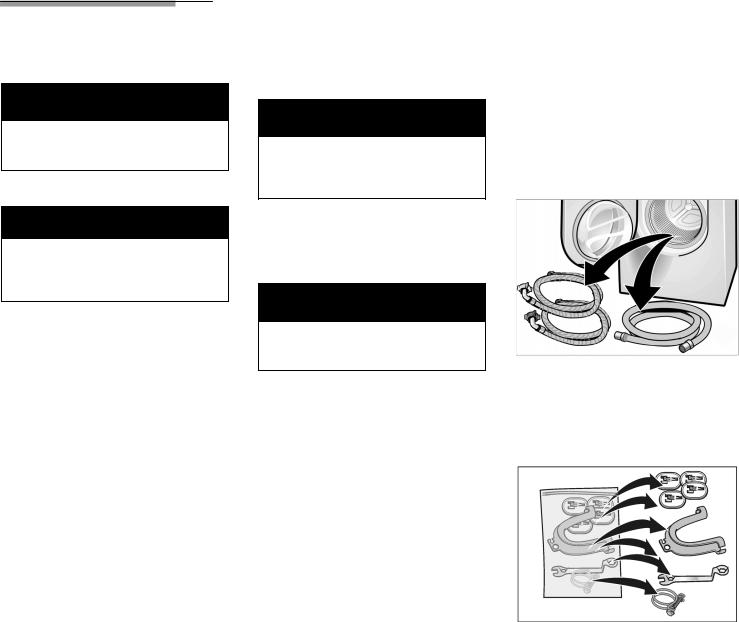
INSTALLATION INSTRUCTION
Introduction
d CAUTION d
TO AVOID RISK OF INJURY
The washing machine is heavy. Lift with caution.
Be sure to observe all listed warnings and cautions.
CAUTION
Frozen hoses can tear/burst. Do not install the washing machine outdoors or in an area exposed to freezing conditions.
These installation instructions are intended for use by qualified installers. In addition to these instructions, if installing the washing machine:
-In the United States comply with the National Electric Code, ANSI/NFPA70 L latest edition/State and municipal and/or local regulations.
-In Canada comply with the Canadian Electric Code C22.1 L latest edition/Provincial and Municipal and/or local regulations.
If the washing machine is located in a room which will be exposed to temperatures below freezing, or if it is located in a cabin that is being shut down for the winter, any residual water in the pump or water inlet hose(s) must be drained.
Take care not to damage the washing machine. Do not hold on to protruding parts (e.g. door) when lifting.
In addition to the safety information listed here, the local water and electricity supplier may have special requirements.
If in doubt, have the appliance connected by an authorized technician.
Informationconcerning waste disposal
Disposing of the packaging
The shipping package has protected your new appliance on its way to your home. All packaging materials are nonLpolluting and recyclable. Please contribute to a better environment by disposing of packaging materials in an environmentally friendly manner.
Please ask your dealer or local authority about the best means of disposal.
d WARNING d
Keep children away from shipping carton and packaging components. Danger of suffocation from plastic foil and folding cartons.
Disposing of your old appliance
Old appliances are not worthless rubbish! Valuable raw materials can be reclaimed from environmentally friendly recycling.
d WARNING d
If appliance is no longer usable, pull out main plug, cut off power cord and discard.
To prevent children from locking themselves in the appliance, disable the door lock or remove the door.
Intended Use
Your washing machine is intended:
-For domestic use only.
-For washing machine washable fabrics in washing water.
-For operation using cold and hot (140 °F/60 °C) tap water and conventional additives that are suitable for use in residential washing machines.
Environmental Protection /Conservation Issues
Your washing machine uses water, energy and detergent efficiently, thereby protecting the environment and reducing your household costs.
To use your washing machine in an efficient and non polluting manner:
-Avoid using too much detergent.
-Use detergent bearing HE symbol for high efficiency and front loading washers.
-Add detergent according to the degree of soiling, amount of laundry and water hardness, and follow the detergent manufacturer's instructions.
Factory supplied equip ment
There is a packet of accessory parts supplied with your washer. Check that all the accessory parts supplied for your model are there. If any parts are missing contact your dealer immediately.
Inside the drum:
-Water supply hose for cold water (blue marking).
-Water supply hose for hot water (red marking).
-Water drain hose.
-A bag which contains:
-Covers to be placed over the holes for the transport bolts (after removing them).
-Clamp for drain hose.
-Wrench for levelling.
-Elbow for attaching the drain hose, e.g. to a sink.
Depending on the type of connection, the following may also be required:
-Y'connector (can be obtained from any hardware store) in case there is only a cold water connection available.
Any residual moisture inside the drum is due to the final testing which every washing machine undergoes before leaving the factory.
5
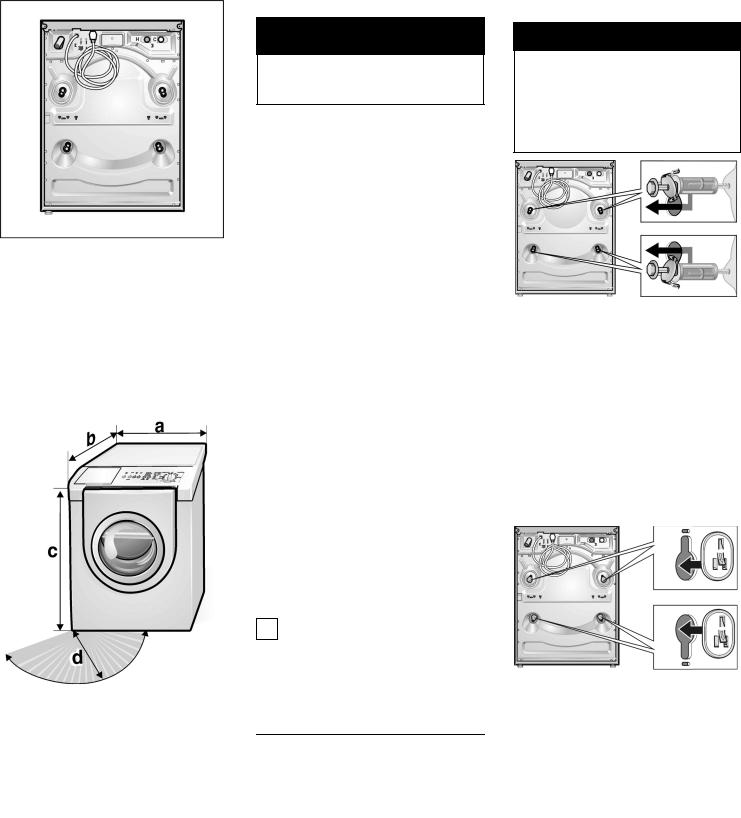
On the rear of the appliance:
-Power cord with plug.
C = cold water connection H = hot water connection
Useful tools
The following tools are helpful:
-Flat head screwdriver.
-Closed wrench (1/2"/13mm).
-Bubble level.
Dimensions
a = 27.0 inches (686 mm) b = 30.7 inches (780 mm) c = 37.0 inches (940 mm)
d = 16.0 inches (407 mm) Door opening angle 180°
Approx. weight = 220 lbs (100 kg)
Installation area
d WARNING d
Never ground the washer to plastic plumbing lines, gas lines or hot water pipes.
This appliance must be installed on a solid floor and well leveled due to the higher spin speeds available. If installing the machine on a wood floor over a basement or on a second floor, the floor may need to be reinforced. Sound, vibration, and risk of •walking" will be affected depending on the structure and stability of the floor surface where it is installed.
If the washing machine is to be installed on a weak wood floor consider the following:
qSoft floor surfaces, such as carpets or surfaces with foam backing, are not suitable. If possible, place the washing machine in a corner of the room.
qScrew a water resistant wooden board (at least 3/4" thick) to the floor.
qSecure the feet of the washing machine with holding brackets. Order the holding brackets (set) from Bosch Customer Service (WMZ 2200).
qUnits are not designed to be stacked.
qUnits are not designed for under counter installation
Pedestal Mounting
If mounting the washer on the Bosch pedestal (accessory no. WTZ1295) fol' low the instructions supplied with the pedestal.
iInstall pedestal prior to removing transport bolts.
Closet
If installing the washer in a closet, observe the minimum distances according to the following table:
Minimum Installation Clearances
|
Closet |
|
|
Sides |
1/4" (6 mm) |
Top |
12" (3O5 mm) |
Rear |
2.5" (64 mm) |
Front |
1/4" (6 mm) |
|
|
Ventilation:
Top: 48 sq. in (310 sq. cm), Bottom: 24 sq. in (155 sq. cm)
Removing the transport bolts
CAUTION
To avoid possible damage to the appliance and adjacent surfaces, all 4 transport bolts must be removed before using the appliance for the first time and must be retained for any future transport (e.g. when moving).
qRelease screws using the 1/2" wrench provided until they can be moved freely.
qcompletely remove transport bolts (bolt, spring, washer and bushings) by reaching through the open wash' ing machine door and pulling the drum slightly forward to loosen, then pull out from the back.
qIf the bushings do not come out when removing the screws, place screws back into the bushings and carefully try again. It is important to do this with the screws, otherwise the bushings will not come out prop' erly.
qInsert the covers until they snap in completely.
6
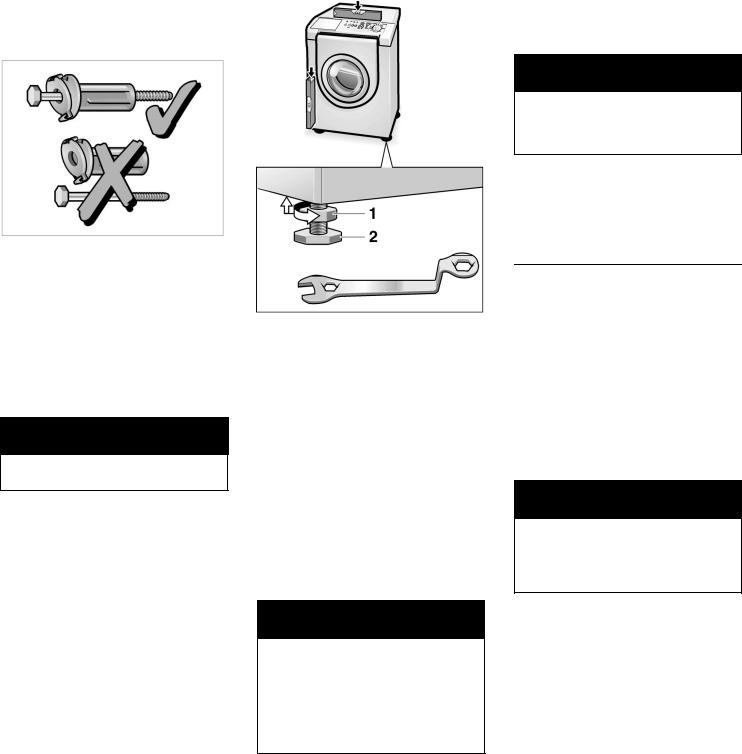
Storing the transport bolts
Always keep the transport bolts for fu' ture transportation of the appliance (such as when moving out).
qStore the transport bolts with the washer and bushing attached.
Leveling procedure
Each foot of the appliance or pedestal must be placed firmly on the ground to prevent the washing machine from wobbling.
Level the washing machine front to back and side to side with the four height'adjustable feet and a bubble level:
d CAUTION d
TO AVOID RISK OF INJURIES-Take care when using the wrench.
qLoosen the counter nut 1 using the wrench for levelling.
qAdjust the height by turning the height'adjustable foot 2.
qTighten lock nut 1 against the housing.
qLevel machine as low as possible.
qFine tune the leveling by placing a small load in the machine, starting the machine in spin cycle and then leveling again.
Electrical connection
GROUNDING INSTRUCTIONS
This appliance must be grounded. In the event of a malfunction or break' down, grounding will reduce the risk of electrical shock by providing a path of least resistance for the electric current. This appliance features a cord with an equipment'grounding conductor and a grounding plug. The plug must be plugged into an appropriate outlet which has been properly installed and grounded in accordance with all local regulations and ordinances.
d WARNING d
Improper connection of the equipment grounding conductor may result in electric shock. Have the appliance checked by
a qualified electrician or service technician if you are in doubt as to whether the washer has been properly grounded.
Do not modify the plug provided with the appliance - if it will not fit in the outlet, have a proper outlet installed by a qualified electrician.
d WARNING d
The washing machine must only be connected to an individual branch circuit via a socket which has been properly installed and grounded.
The household electrical voltage must correspond to the voltage specification on the washing machine (rating plate, see page 24).
Connection specifications as well as the required fuses are stipulated on the appliance rating plate.
Volts |
Hertz |
Amperes |
Watts |
|
|
|
|
110-120 |
60 |
15 |
1350 |
|
|
|
(max.) |
|
|
|
|
Make sure that:
-the power plug fits into the socket.
-the wire size is sufficient.
-the grounding system is properly installed.
The power cord may be replaced by an electrician only.
Replacement power cords are available from Customer Service.
d WARNING d
To reduce the risk of fire or electrical shock, DO NOT use an extension cord or an adapter to connect the washing machine to the power supply.
If an ground fault circuit breaker is to be used, only use types marked with the following symbol: 7.
Only this symbol can guarantee compliance with all current regulations.
Do not insert/remove the power plug with wet or damp hands.
Touch the plug only when removing the plug from the socket.
7

Hose and cable lengths
Left hand connection
a
b
d
c
a = 55.0 in. / 140 cm (approx.) b = 51.0 in. / 130 cm (approx.) c = 33.5 in. / 85 cm (approx.) d = 39.0 in. / 100 cm (max.)
e = 69.0 in. / 175 cm (approx.) f = 34.6 in. / 88 cm (approx.) g = 55.0 in. / 140 cm (approx.)
Right hand connection
e
f
d
g
Other hoses
Available from appliance dealers:
-Extended supply hose (approx. 96.1 in. /2.44 m).
8
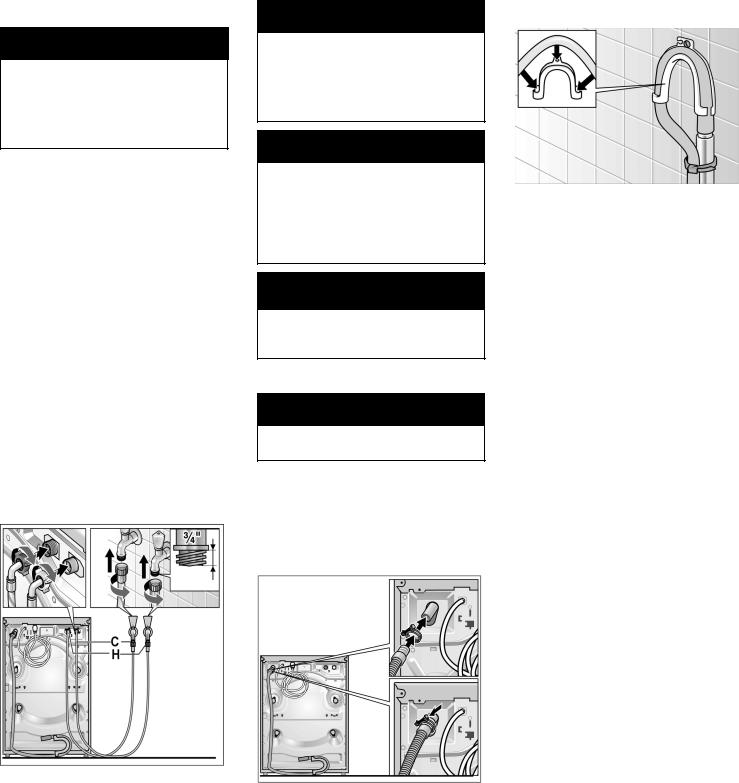
Water connection
Water supply
CAUTION
The washing machine must only be operated with cold and hot (max. 140 °F / 60 °C) tap water. Do not connect the appliance to the mixer tap of an unpressurized hot'water boiler.
If in doubt, have the water connection installed by an authorized technician.
The water supply hoses must not be:
-Bent or flattened.
-Modified or cut (integrity can no longer be guaranteed).
Plastic threads must only be tightened by hand. Do not remove the strainers from the water supply hoses.
Observe the water pressure in the supply network:
-The water pressure should be between 14.5 and 145 p.s.i. (1 and 10 bars) when the tap is turned on, at least 2.2 U. S.
gallons (8 liters) of water should be discharged per minute.
-A pressure regulator valve must be installed if the maximum water pressure is exceeded.
Connection
C Cold water connection and
HHot water connection (max. 140 °F / 60 °C)
min.0,4'' (10 mm)
qAfter connecting,
turn on the water completely, and check that connection points are watertight.
CAUTION
To prevent water damage, the hot and cold water valves should be accessible when the washing machine is in place and should always be turned off when the washing machine is not in use.
CAUTION
If installing the washing machine in a new building or a building in which the plumbing system was recently installed or upgraded, flush the lines before installing the washing machine to remove any sand, dirt or residue.
d CAUTION d
The connection points are under full water pressure. Check seal with tap fully open.
Water drainage
CAUTION
Do not bend or pull the water drainage hose.
Height difference between the installation location of the washing machine and the drainage point: Maximum 8 feet / 244 cm.
Connecting the water drainage hose
qAttach the drain hose to the end of the drain connection.
qSecure the connection point with the clamp and tighten.
Standpipe Installation
qUse the elbow. Attach the elbow to the end of the hose and insert end of hose into standpipe.
qUse a strap or cable tie to hold hose in place.
9
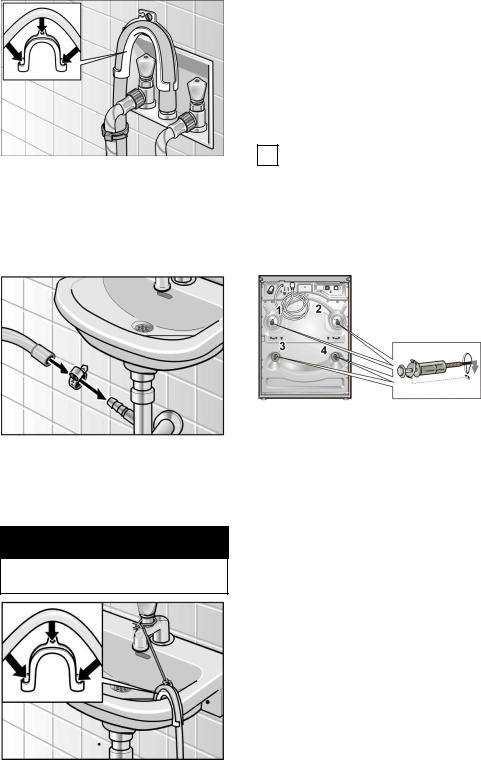
In-Wall Installation
qUse the elbow. Attach the elbow to the end of the hose and insert end of hose into wall drain.
qUse a strap or cable tie to hold hose in place.
Drainage into a siphon
qSecure the connection point with a hose clip(not included in factory-supplied equipment).
Drainage into a sink
CAUTION
Ensure that the plug is not in the drain hole.
qAttach water drain hose securely to sink.
qUse a strap or cable tie to hold hose in place.
qWhen the water is being drained, check that the water flow out of the sink is adequate.
Transport, such as when moving out
Before transporting the washing machine:
-Turn off the water.
-Disconnect the washing machine from the power outlet.
-Dismantle the supply and drainage hoses.
-Install the transport bolts.
iHaving transported the appliance
and ensured proper installation and connection, allow the Drain program to run through before starting the first wash program.
Preparing and inserting the transport bolts
qRemove the covers.
qPrepare the transport bolts: Loosen the screw in the sleeve until the end of the screw is level with the end of the sleeve.
qInsert and tighten all transport bolts. Make sure that the tab on the transportation bolt is inserted in the slot on the washing machine back panel.
10
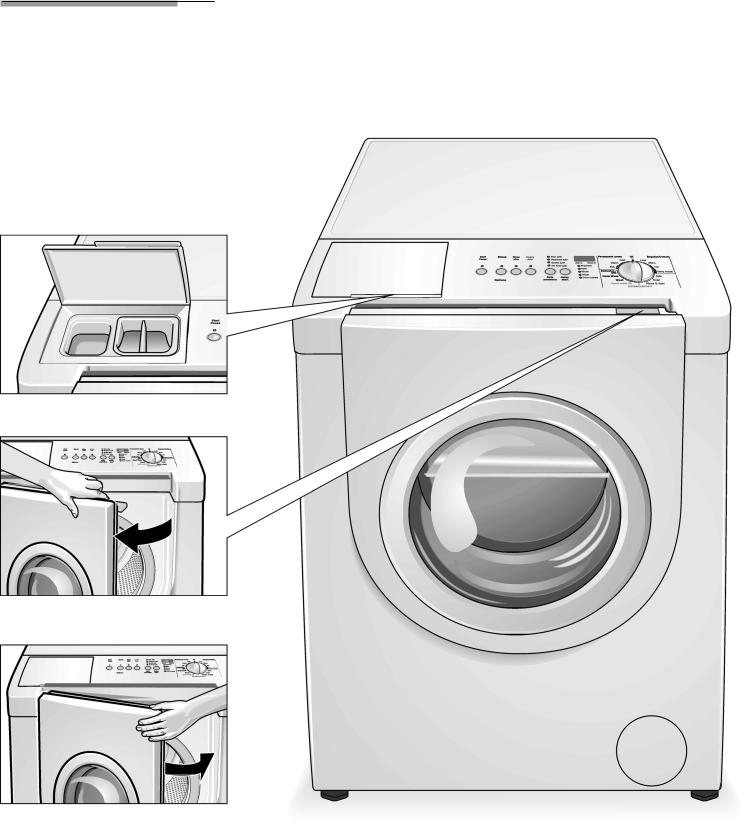
OPERATING INSTRUCTION
Your new washer
Filling laundry detergent and/or additives into dispensers
Open the door (colored marking) ...
...and close the door
Access panel located on the bottom right corner of the washer is for Service Access Only.
11
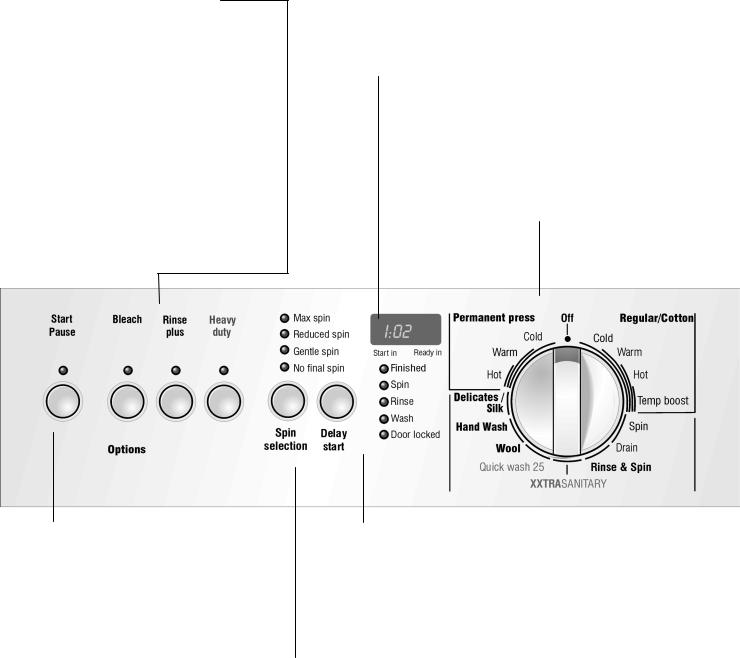
Panel
Buttons for additional options
(in addition to the program if required)
Bleach: A bleach cycle will be added to the selected program.
Rinse plus: Additional rinsing cycle.
Heavy duty: Increased wash time for heavily soiled loads.
Additional options can be combined at any time.
Additional option selected:
Indicator light is lit red.
Switch off additional option:
Press button again. Indicator light turns off.
Start/Pause button
Starts or interrupts the washing cycle (program must first be selected).
Indicator light
Indicator light flashes red: Settings can be changed, the wash cycle can be started, door is locked for reasons of safety or program is in •Pause" mode.
Display
The Ready in time is displayed, if a program is selected. The Start time is displayed, if this function is additionally
selected.
Program selector
Switches the machine on and off and selects the program.
Can be turned in both directions.
The program selector does not turn while the program is running - the program sequence is electronically controlled.
Indicator lights
The door locked lights up if a program is selected and the
Start button is pressed.
The wash, rinse and spin lights up if the respective
program segment runs.
The finished lights up if the program has ended.
Indicator lights flash: Operation error!
Indicator light is lit red: Program is running and "Pause" can be activated.
The indicator light is off: Program is finished or no program selected.
Delay start button
The Start time can be delayed by hours up to a maximum
of 19 hours (if required).
The display shows the Delay start time.
Spin Selection button
For changing the spin speed (if required). The indicator light of the selected spin speed is lit red.
12
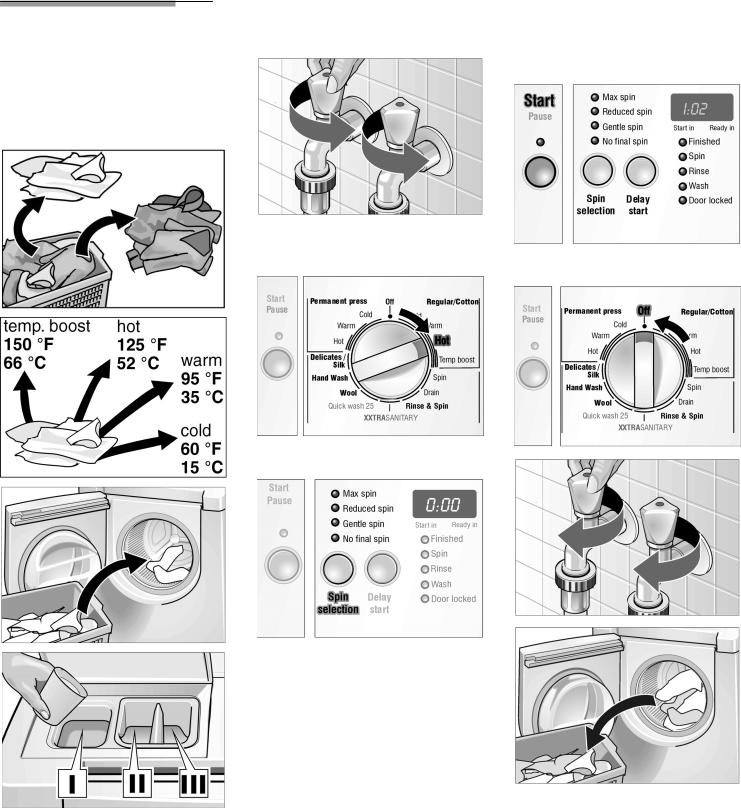
Summary of instructions
d Warning |
turn on |
Before using your washing machine, |
|
read and follow all installation and |
|
operating instructions. |
|
Preparing the laundry
Select a cycle and start the machine
Select desired settings
load
press start
After washing
close
unload
13
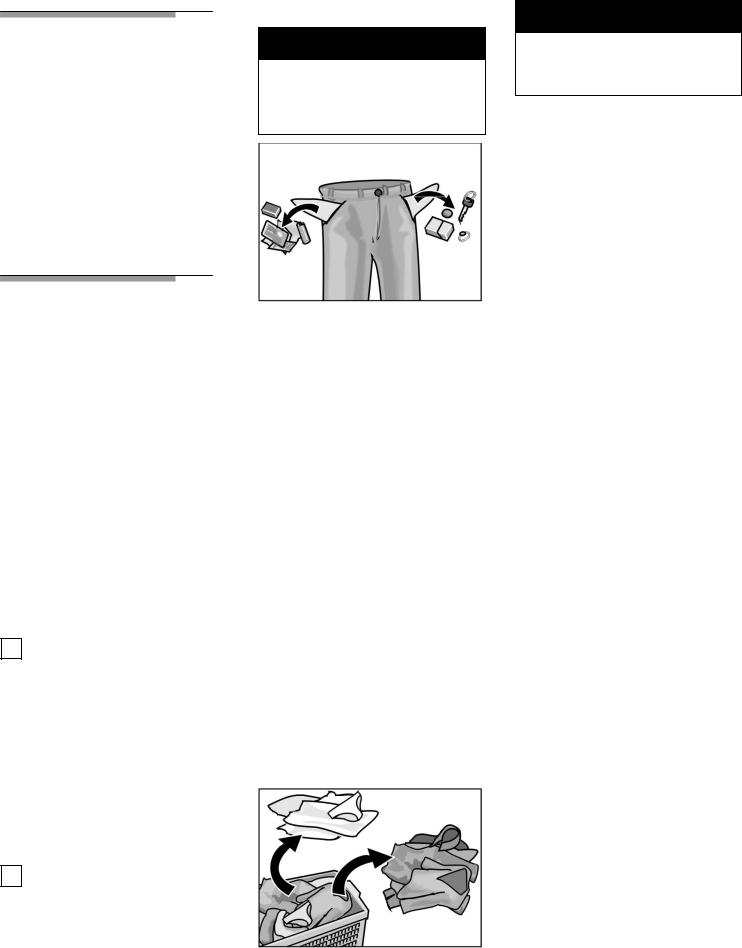
Before Using For the First Time
The washing machine must be installed and connected properly (refer to Page 5).
Before using your washing machine for the first time:
qMake sure that the supplied volt' age is the same as the voltage shown on the rating plate.
qCheck that the water valves for the washing machine have been con' nected correctly and are open.
Using For the First Time
First washing cycle (with out laundry)
Your appliance was tested before leaving the factory. To ensure a fresh wash with your initial load of clothes, run the washer a complete cycle, without clothes, in advance.
qDo not load any laundry.
qTurn on the water tap.
qOpen the flap of the detergent dispenser.
qPour approx. 1 quart (1 liter) of water into the detergent chamber I; see Page 16.
qPour 1-2 Tbsp. detergent into detergent chamber I.
iDo not use special detergents for
delicates or wool (this will cause excessive sudsing).
qClose the flap of the detergent dispenser.
qClose the door.
qSet the program selector to
Regular/Cotton hot.
The Start/Pause indicator light flashes red.
qPress the Start/Pause button. The program starts.
The indicator light is on (red).
iThe display shows the run time of program.
When the display shows •0:00":
qOpen the door.
qTurn the program selector to Off.
Preparing the laundry
CAUTION
Loose debris (coins, paper clips, nails and other hard objects) can damage items of clothing as well as parts of the washing machine (e.g. drum).
qEmpty all pockets.
qBrush off lint and dirt.
qClose zippers, button up duvets and hooks.
qRemove curtain rings or tie them up in a net bag.
qRemove pins, buttons, buckles and other hard objects to avoid scratching the washer interior.
qRemove non'washable trim and ornaments.
qTurn synthetic knitwear inside'out to avoid pilling.
qTreat spots and stains.
To prevent loss or damage to laundry and the machine, the following items should be washed in a mesh laundry bag:
qBaby socks (small items)
qHosiery
qBelts
qUnderwired bras (directly washed in the washer, the wire may come loose during wasing and cause damage)
Sorting the laundry
According to color and degree of soiling
CAUTION
Items of clothing may become discolored. Never wash new multi'colored items together with other items.
White items may become gray. Always wash white and colored items separately.
Degrees of soiling
Slight dirt
No recognizable dirt or staining. Laundry may have some body odor.
-Light summer clothing.
-TLshirts, shirts and blouses that have been worn for up to one day.
-Bed linen and guest towels that have been used for one day.
Normal dirt
Visible dirt and/or some light recognizable staining.
-TLshirts, shirts and blouses that are very sweaty or have been worn several times.
-Dish towels, hand towels and bed linen that have been used for up to one week.
-Sheer curtains (without smoke staining) that have not been washed for up to 6 months.
Intensive dirt
Dirt and/or staining recognizable.
-Kitchen hand towels that have been used for up to one week.
-Cloth napkins.
-Bibs.
-Children's outer clothing or sportswear with grass and soil stains.
-Working clothes such as overalls or baker's and butcher's coats.
Typical stains
-Body oils, cooking oils/grease, sauces, mineral oil, wax (containing fat/oil).
-Tea, coffee, red wine, fruit, vegetables.
-Blood, egg, milk, starch (containing protein/ carbohydrate).
-Soot, soil, sand (pigments), red clay.
Removing stains
If possible, pretreat stains while they are still fresh.
First, dab soapy water onto the stain. Do not rub.
Subsequently, wash the items of clothing using the appropriate program.
14
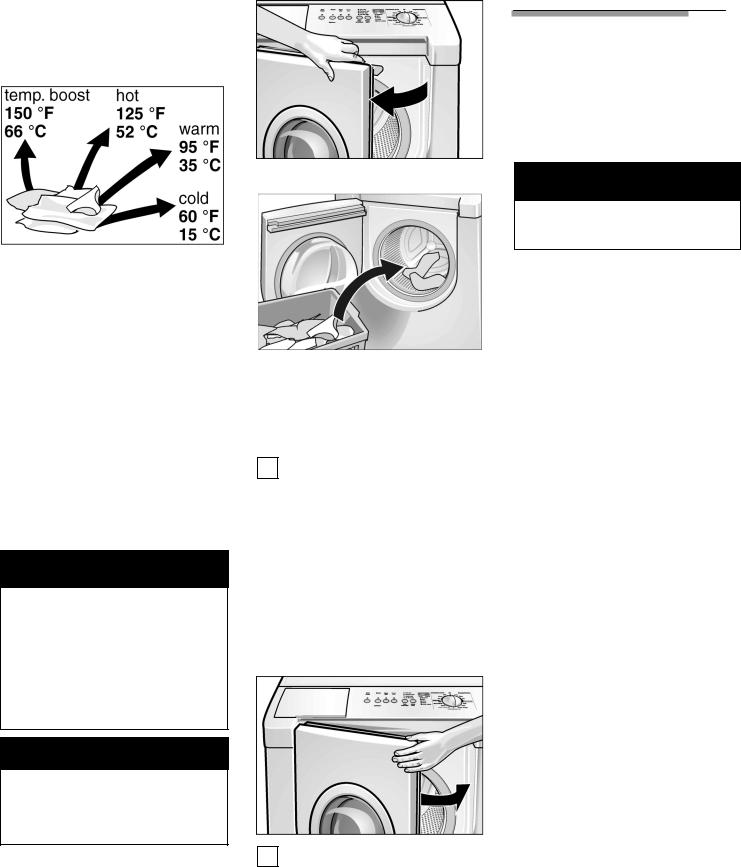
Occasionally, several wash cycles may be required in order to remove persistent, dried on stains.
Sorting laundry according to care label specifications
See also temperatures settings page 17.
Fabric Types |
Ó |
Machine Wash, Cottons |
|
Machine Wash, |
Ô |
Permanent Press |
|
Machine Wash, Delicates |
Ò |
Hand Wash |
Ì |
Temperatures |
|
Cold |
Á |
Warm |
Ê |
Hot |
 |
Do not wash clothes in washing machine if the care label says •Do Not Wash" or the DO NOT WASH symbol Ú is on the care label.
Loading the laundry
d WARNING d
TO AVOID EXPLOSION HAZARD!
Items of clothing that have been pretreated with solvent'based cleaning agents, e.g. stain remover and dry cleaning solvents, represent an explosion hazard once loaded into the washing machine. Therefore, these items must first be rinsed thoroughly by hand.
CAUTION
Loose debris in the washing machine drum can damage the laundry. Before loading the laundry, check that there is no debris in the drum.
qOpen the door.
qUnfold the sorted items of clothing and place them loosely into the drum. Mix up large and small items. Items of varying size will distribute better during the spin cycle.
iDo not exceed the maximum load.
Overloading will cause poor wash results and will increase wrinkling.
For best results it is recommended to load the drum depending on the fabric type, see special programs Page 16 for information on bulky items, e.g. comforters :
Full Load
Cotton and Linens
½ Load
Permanent Press, Synthetic Blends and Knitwear
D Load
Wool, Delicates, Silk
iClose the door.
Do not trap any items of clothing between the door and rubber seal.
Door should be able to close easily, not by force.
Laundry Detergents and Additives
Dispensing the correct amount of detergent
d WARNING d
TO AVOID RISK OF POISONING! Keep detergents and additives out of the reach of children.
Measure out the detergent (powder or liquid) according to:
-The water hardness. This information can be obtained from your local water authority. Soft water requires less detergent.
-The amount of laundry.
-The degree of soiling. Information on soiling can be found on Page 14.
-The specifications of the detergent manufacturer. Measuring the correct amount of detergent reduces the strain on the environment and ensures optimum washing results.
15
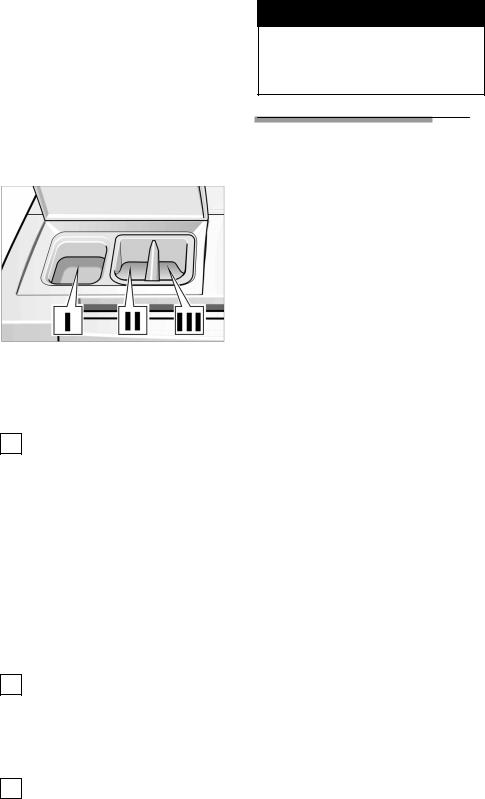
Too little detergent:
The laundry is not cleaned properly and will eventually become gray and stiff. Grayish brown spots (fat globules) may appear on the laundry. The heater may calcify.
Too much detergent:
Not environmentally friendly, excessive suds reduce wash agitation producing poor washing and rinsing results or may prevent proper spinning.
Filling laundry detergent and/or additives
qOpen the flap of the detergent dispenser.
qAdd the detergent and/or additive.
Dispenser I:
Dispenser for detergent, stain remover.
iWe recommend HE detergents
because they are particularly designed to deliver optimum performance from your front-loading washer. Not using HE detergent could cause problems such as oversudsing, extended cycle periods, or a decrease in wash performance.
Dispenser II:
Cleaning additives, e.g. fabric softener, fabric conditioner. Do not fill over edge of max line!
Dispenser III:
Dispenser for liquid bleach (chlorine bleach, color safe bleach).
Do not overfill!
iConcentrated or thick fabric
softener, conditioner and powder-bleach must be diluted with a little water before being poured into the dispenser (prevents overflow due to obstruction).
iClose the flap of the detergent
dispenser. Please ensure the lid is entirely closed.
Decolorizing
CAUTION
Dyes may contain sulphur or chlorine. These substances may cause parts of the washing machine to corrode. Do not dye items of laundry in the washing machine.
Programs and Functions
Cycle time will vary depending on cycle selected, temperature and pressure of incoming water, water hardness, size of load, type of fabrics and distance of unit from the drain.
The maximum spin speeds of the programs are dependent upon the cycle. For adjusting the spin speed, see page 17.
Basic programs
Regular/Cotton Temp boost
Regular/Cotton settings are intended to be used for heavily soiled and/or stained colorfast fabrics. Sturdy, hard-wearing items made of cotton or linen such as towels, sheets or white sports socks.
Regular/Cotton hot
Normally and/or heavily soiled colorfast fabrics. Sturdy, hard wearing items made of cotton or linen such as work clothes and underwear.
Regular/Cotton Warm
Lightly and/or normally soiled non'colorfast fabric. Sturdy, hard wearing items made of cotton or linen such as jeans, T'shirts and sweatshirts.
Regular/Cotton Cold
Lightly soiled non'colorfast fabric. Sturdy, hard wearing items made
of cotton or linen (colors that may bleed or fade).
Permanent Press Hot
Items consisting of normally soiled colorfast cotton, permanent press, linen, synthetic or blended fabrics and outer garments. Clothes requiring a special tumble sequence and spin speed to minimize creasing.
Permanent Press Warm
Items consisting of lightly and/or normally soiled non'colorfast cotton, permanent press, linen, synthetic or blended fabrics and outer garments. Clothes requiring a special tumble sequence and spin speed to minimize creasing, such as blouses, shirts and overalls.
Permanent Press Cold
Items consisting of lightly and/or normally soiled non'colorfast cotton, permanent press, linen, synthetic or blended fabrics and outer garments. Clothes requiring a special tumble sequence and spin speed to minimize creasing.
Special programs
Delicates/Silk
Delicates/Silk settings are intended for use with delicate easy care items made of cotton, satin, synthetic, or blended fabrics and curtains, dresses, skirts and blouses.
Bulky items, e.g. comforters, can be washed with this cycle because of gentle action and additional rinse (automatically added).
No spinning between rinse cycles.
Hand Wash
Hand Wash settings are intended for very delicate easy care items that usually require hand washing.
These cycles have been specifically designed to provide extremely gentle treatment of fabrics.
Silk or other items marked with the •Hand Wash" symbol Ìon the care label can be safely washed with this cycle.
Wool
Woolens (machine wash and hand wash).
Quick Wash 25
For mixed load, e.g. cotton, linen, synthetic materials or blended fabrics, lightly soiled.
XXTRA SANITARY
This program was specifically designed to eliminate most common houshold bacterium while providing gentle treatment of fabrics. At the beginning of the washing phase, hot water is introduced and then the internal heating element heats the water to 167ºF-174ºF for a minimum of three minutes. Clothes will be saturated in the hot water long enough to kill most common household bacterium, yet without causing additional wear and tear to the clothes.
Used for heavily soiled and/or stained colorfast fabrics that need to be sanitized, such as, towels, underware, socks, bed sheets, table clothes, etc.
16
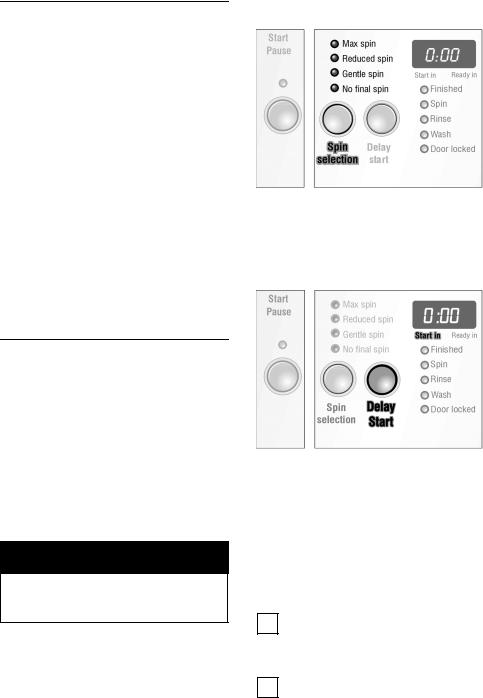
During the washing phase, the drum rotates in opposite directions at 40 rpm repeatedly. Spin speed reaches 1100 rpm for both intermediate and final spin to reduce the remaining moisture content and chemical residues contained in the loads as well as optimize the rinsing efficiency.
Additional options can be selected for this program such as •Rinse plus", •Bleach", and •Heavy duty". All these options can be selected individually or simultaneously.
Selecting •Rinse plus" will add an additional rinse to the program to better remove chemical residue.
Selecting •Bleach" option will ensure bleach dispensation at the right time. The dynamic load sensor will add enough water to dilute the bleach, preventing bleach marks on the clothes.
•Heavy duty" option will extend the wash phase to a longer period of time to achieve optimum wash performance (see detailed explanation of heavy duty).
Rinse and Spin
Program for rinsing unsoiled textiles, e.g. swimwear, and for removing detergent residue from textiles. Ends with a spin cycle.
Spin
Spin cycle for spinning wet, hand washed laundry.
Water is drained before and during the spin cycle.
Drain
Can be used to drain water without a spin cycle.
Temperature Settings
The following wash temperatures are available:
XXTRASANITARY170 °F (77 °C)
Temp. boost: |
150 °F (66 |
°C) |
(only Regular/Cotton) |
°C)- |
|
hot: |
125 °F (52 |
|
warm: |
95 °F (35 °C) |
|
cold: |
60 °F (15 °C) |
|
Maximum spin speeds of the programs
The indicator light •max spin speed" is lit red.
Revolutions |
|
Program |
per minute |
|
|
|
|
|
1100 |
|
Regular/Cotton |
|
|
|
800 |
|
Permanent Press |
|
|
|
600 |
|
Delicates/Silk |
|
|
|
800 |
|
Wool |
|
|
|
1000 |
|
Qucik Wash 25 |
|
|
|
1100 |
|
Spin |
|
|
|
1100 |
|
Rinse and Spin |
|
|
|
1100 |
|
XXtra Sanitary |
|
|
|
Reduced spin
The indicator light •reduced spin" is lit red.
Only if you have selected a reduced spin speed for gentle treatment of your laundry.
Gentle spin speeds
The indicator light •Gentle spin speed" is lit red.
Revolutions |
Program |
per minute |
|
|
|
400 |
Hand Wash |
|
|
No final spin
The indicator light •no final spin" is lit red.
For delicate laundry, the water remains in the machine after the last rinse.
Use this setting to avoid creasing if the clothing cannot be taken out of the washing machine immediately upon completion of the cycle.
CAUTION
Before unloading you must drain the remaining water by selecting Drain or Spin and starting the machine.
Modifiers
Spin Selection
Preset cycle setting of max. spin speed can be reduced.
Press this button until the desired setting is indicated.
Delay Start
Before starting a program you can modify when the cycle should be started.
Press Delay Start button. The display shows the start time 0:00.
The time can be delayed up to a
maximum of 19 hours (with 1 hour increments) by pressing theDelay Start
button repeatedly.
The Start time begins running
immediately after pushing the Start/Pause button. This is indicated
by the points between the digits flashing.
iChanges to the Start time are
possible at any time, press the Delay Start button until the new time appears.
iIf the program is changed or if the
program is interrupted, the preselected Start time is also interrupted. The Ready in time of the program is displayed. The Start time must be reselected.
17
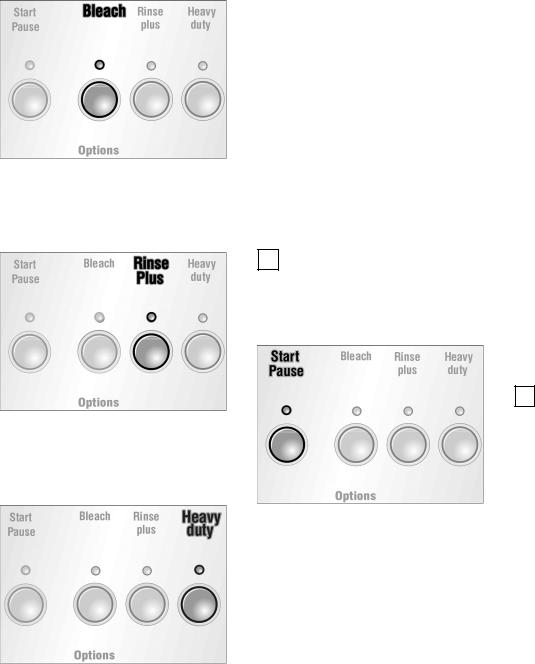
Option buttons
Bleach
When this button is pressed, a bleach cycle will be added to the selected cycle.
The washing cycle time is extended accordingly.
Rinse Plus
When this button is pressed, an additional rinsing cycle will be added to the selected cycle.
Washing cycle time is extended accordingly.
Heavy duty
The Heavy duty option is recommended for use ONLY for heavily soiled clothes that require the removal of tough, ground-in protein-based stains. It is NOT recommended to use the Heavy duty option with other cycles when laundering normal or lightly soiled clothes.
Washing time is extended.
Only cold water is introduced to the drum. The washing machine then heats the water to the selected wash temperature. By raising the temperature from cold up to the set temperature all components of the
detergent are activated in stages for best stain removal and cleaning results.
Acoustic Signal
An acoustic signal indicates program statuses (e.g. start/end of program and operating faults.)
To activate the signal:
qSelect a program.
qPress two of the Option Buttons(e.g. Bleach and Rinse Plus) until a long signal is emitted.
To deactivate the signal:
qSelect a program.
qPress two of the Option Buttons and hold until a short signal is emitted.
iDo not activate/deactivate the acoustic signal during a cycle.
Indicator light above the •Start/Pause" button
The indicator light conveys the following information:
-Indicator light flashing red: Program can be started. Adding laundry is possible.
-Indicator light is lit red. Program is running. Adding laundry is not possible because the door is locked for safety reasons.
Laundry may be added after pressing the Start/Pause button.
Special features
Auto Load adjust
•Auto Load adjust" adjusts the water and energy consumption for each program and determines the amount of laundry and type of fabrics.
This process is built into your machine and occurs automatically.
This control reduces water and energy consumption when washing small loads.
Unbalanced load detection system
The automatic unbalanced load detection system spins the laundry several times to ensure even distribution.
If the wash load is unevenly distributed, it will not spin (for safety reasons) or the final spin speed is reduced.
In the wool program the appliance will attempt to start the spin cycle only twice in order to prevent shrinking.
Displayed Time
Due to these and other characteristics of the controls the actual cycle time will vary.
When a program has been selected, the expected program duration is displayed.
The following will effect the displayed time:
-Load size
-Repeated spin attempts to evenly distributed load
-Additional rinse cycles if excessive foam occurs
-Water pressure is too low
-Selection of additional options, e.g. •Rinse plus"
iYou may notice these effects
(more or less time) changes the displayed time when they occur in the cycle. If no options are selected and these effects do not occur, the time indicated will count down until the end of the cycle.
18
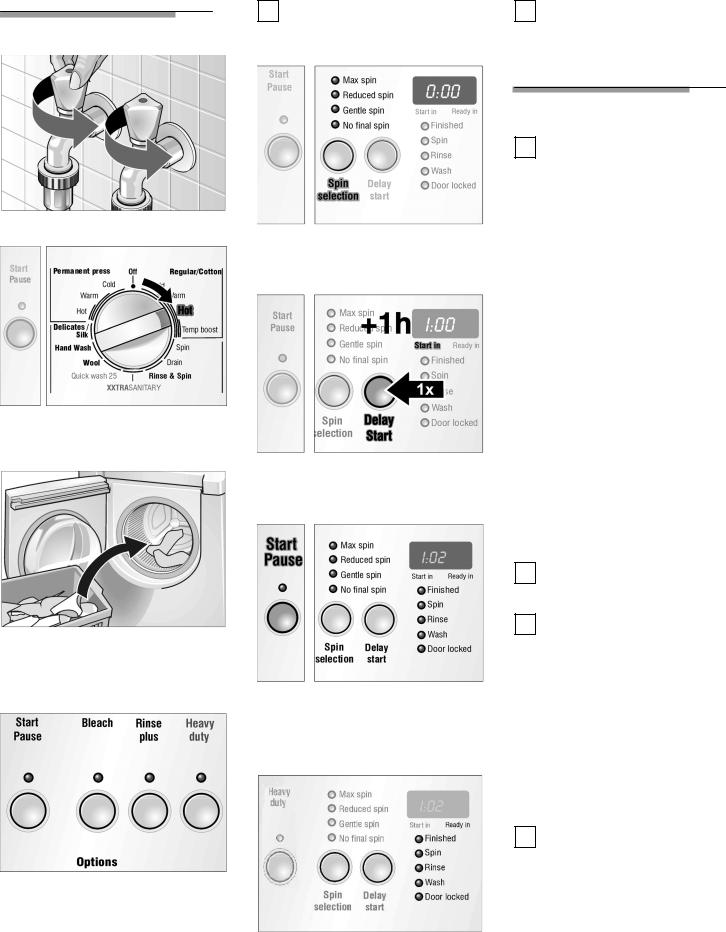
Washing
qTurn on the water taps.
qTurn the program selector to the desired program.
qLoad the washing machine and close the door.
The Start/Pause indicator light flashes (red).
qIf necessary, press the button(s) for additional option(s).
The indicator light of the selected button is lit (red).
iIf an incorrect combination was
inadvertently selected, the indicator light of the selected button is turned off.
qIf necessary, change the spin speed with the Spin selection button until the the desired spin speed indicator light is lit.
qIf necessary, change the Start time. Press the Delay Start button until the desired Start time is displayed.
qPress the Start/Pause button. The indicator light is lit (red). Display shows the run time of the selected program. The program starts.
iEach program step is indicated by
the indicator lights under the display.
During Washing
iDue to the highly engineered
suspension of this appliance, it may experience a shudder or shake when progressing from lower to higher spin speeds. This behavior is normal due to shifting of the drum system and should not cause concern.
Changing a program
qTurn the program selector to Off.
qTurn the program selector to a newly selected program.
The Start/Pause indicator light flashes.
qIf required, change the settings; see from Page 17.
qPress the Start/Pause button. The program starts.
The indicator light is lit.
Add a garment / Interrupting the program
You can put laundry in the drum after washing begins, take laundry out of the drum early or interrupt the program at any time.
iIt is not recommended to add
laundry after the washing phase is complete.
iYou can add or reduce laundry as
long as the Start/Pause indicator light flashes (red).
qPress the Start/Pause button. The Start/Pause indicator light flashes.
qOpen the door.
qPlace/remove the laundry.
qClose the door.
qPress the Start/Pause button. The program continues.
The indicator light is lit (red).
iWhen the Start/Pause indicator
light is lit (red), the program can be interrupted, however the door cannot be opened for safety reasons (water level, temperature or speed too high).
19
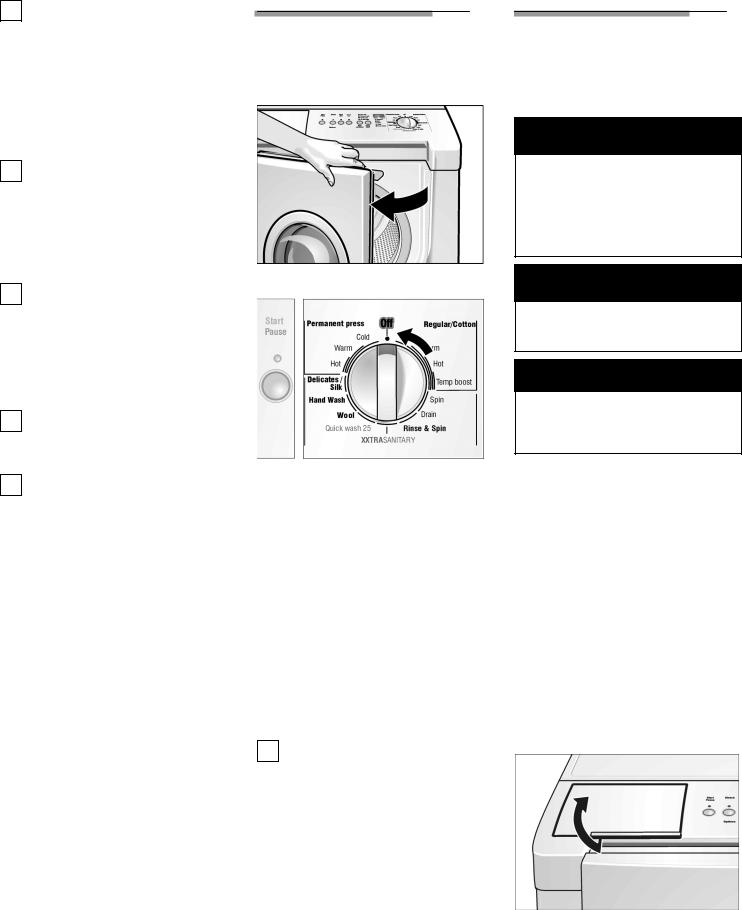
iIf the spin speed is too high, the
Start/Pause indicator light is lit (red). Laundry can be added in •Pause" mode when the drum is at a standstill.
Canceling an active program
If you would like to terminate a program and remove the laundry:
iIf a program is interrupted at a high
temperature, leave the laundry to cool down until the glass is cool to touch.
qTurn the program selector to Off.
qTurn the program selector to Drain or Spin.
iFor Spin, select the desired spin speed (but not no final spin).
qPress the Start/Pause button.
qWait until this program ends.
qOpen the door.
qUnload the laundry.
iIf a program is interrupted at a high
temperature, the door may remain locked until the appliance has cooled down.
iIf the program is terminated by
switching off the appliance, the door may remain locked.
After Washing
The Start/Pause indicator light goes out.
0:00 appears in the display.
qOpen the door.
qTurn the program selector to Off.
qClose the taps.
qRemove the laundry.
If •No final spin" preselected
The Start/Pause indicator light flashes.
qTurn the program selector to
Drain. The Start/Pause indicator light flashes.
qPress the Start/Pause button. The indicator light is lit.
qWhen this program has ended, open the door.
qTurn the program selector to Off.
qClose the taps.
qRemove the laundry.
iLeave the loading door ajar to
allow the inside of the washing machine to dry.
Cleaning and Care
Cleaning the washer
d WARNING d
TO AVOID RISK OF ELECTRIC SHOCK!
Always disconnect the appliance from the power outlet before cleaning.
Never clean the washing machine with a pressure washer.
d WARNING d
TO AVOID RISK OF EXPLOSION! Never use flammable solvents to clean the appliance.
CAUTION
Occasionally check for any foreign objects (e. g. coins, paper clips)
between the drum and rubber seal -TO AVOID Risk of rust!
Cleaning the appliance housing and control panel
As required:
qUse hot soapy water or a mild, non'abrasive cleaning agent.
qRub dry with a soft towel.
Cleaning the drum
If rust spots have formed due to left'over debris (e.g. coins, paper clips, nails):
qUse a chlorine'free cleaning agent. Follow the manufacturer's instructions. Never use steel wool.
Cleaning the detergent dispenser
If residual detergents or additives have accumulated
or if softener/bleach are not fully rinsed out:
qOpen the flap of the detergent dispenser.
20
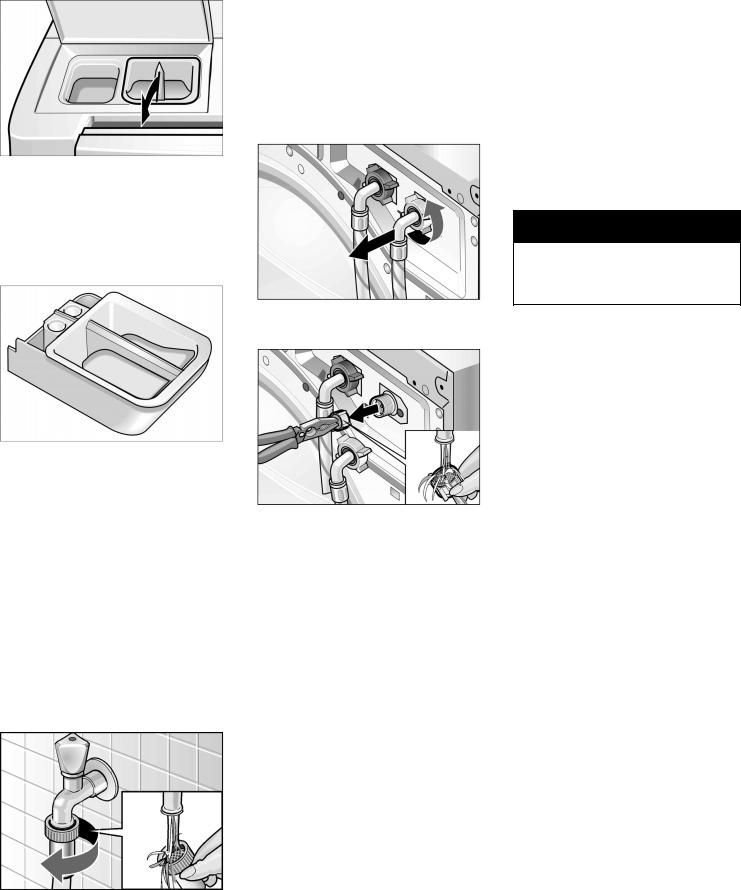
qPull out the softener/bleach compartment in a vertical direction and remove.
qClean the detergent dispenser under running water.
The detergent dispenser can be disassembled into two parts!
qInsert the detergent dispenser until it clicks into place.
Cleaning water inlet strainers
This is necessary if very little or no water flows into the washing machine.
First release the water pressure in the supply hoses:
qTurn off the water taps.
qTurn the program selector to any program (except Spin or Drain).
qPress Start/Pause button and wait approximately ten seconds.
qTurn the program selector to Off.
Cleaning the strainer(s) on the water tap
In both the hot and cold water tap:
qDisconnect the hose from the water tap.
qRinse the strainer under running water.
qReconnect the hose.
Cleaning the strainers on the washing machine
On both the hot and cold water tap:
qDisconnect the hose from the back of the washing machine.
qPull out the strainer and rinse under running water.
qInsert the strainer and reconnect the hose.
qTurn on the water taps and check that there are no leaks. If water is leaking, check that the strainer is properly attached.
qTurn off the water taps.
Cleaning Tips
It is recommended that a small amount of household bleach be run through the washer every 3 months.
With no laundry in the machine, run the machine as follows:
qPour 1 cup of bleach in Detergent compartment of the dispenser
qRun a Regular/Cotton Hot program
Descaling the washing machine
CAUTION
Descaling agents contain acids which may attack parts of the washing machine and discolor the laundry.
Provided that you use the correct type of detergent, it is not necessary to descale the washing machine.
If white spots, lime or mineral deposits appear on the interior of the washing machine drum you can use a descaling agent to remove them.
However, if the appliance has to be descaled, please follow the
instructions provided by the descaling agent manufacturer.
21

Troubleshooting of Minor Faults
d WARNING d
TO AVOID RISK OF ELECTRIC
SHOCK!
Repairs should only be carried out by an authorized technician.
If repairs are necessary, and you cannot eliminate the fault yourself with the aid of the following table:
qTurn the program selector to Off
qDisconnect the washing machine from the power outlet
qTurn off the water tap
qCall Customer Service (refer to Page 24)
Fault |
Possible cause |
|
Action |
|
|
|
|
The door cannot be |
•No final spin" selected. |
|
Select Drain or Spin. |
opened. |
|
|
|
Power failure. |
|
An interrupted program will be resumed when power is |
|
|
|
|
restored. If the laundry is to be removed during a power |
|
|
|
failure, call Customer Service |
|
|
|
(refer to Page 24). |
|
|
|
|
|
Program is running and/or the door is locked for safety |
|
Wait until the program ends; see Page 20. |
|
reasons. |
|
|
Plug is loose or not inserted.
Program selector turned to Off before end of program.
Eliminate the cause.
Select a program.
Door cannot be opened, |
|
For safety reasons the door has been locked because the |
|
See "Add a garment/Interrupting the program", Page 19. |
even though the appliance |
|
water level, temperature or speed is too high. |
|
|
has been switched off and |
|
|
|
|
on again. |
|
|
|
|
Control lights do not light up.
Program does not start. Start/Pause indicator light
flashes.
A fuse has blown.
Power failure.
Start/Pause button not pressed.
Reset circuit breaker.
Call Customer Service if this fault recurs.
An interrupted program will be resumed when power is restored. If the laundry is to be removed during a power failure, call Customer Service
(refer to Page 24).
Press the Start/Pause button.
Program does not start. |
|
Door not closed properly. |
|
Check whether laundry is trapped in door. |
|
|
|
||||||||
Indicator light •end" is lit |
|
|
|
|
|
|
|
|
|
|
|
|
|
|
|
|
|
|
|
|
|
Close the door (a click should be heard). |
|
|
|
||||||
and display is flashing |
|
|
|
|
|
|
|
|
|
||||||
|
|
|
|
|
|
Program continues. |
|
|
|
|
|
|
|||
•E:01" |
|
|
|
|
|
|
|
|
|
|
|
|
|
||
|
|
|
|
|
|
|
|
|
|
|
|
|
|
|
|
|
|
|
|
|
|
|
|
|
|||||||
Spin speed cannot be |
|
Spinning is already in progress; during spin cycle the |
|
Select speed before spinning. |
|
|
|
|
|||||||
selected. |
|
|
speed cannot be changed. |
|
|
|
|
|
|
|
|
|
|||
|
|
|
Program selector is setdrainto ; spin cycle is not |
|
If required, |
select |
another program. |
|
|
|
|||||
|
|
|
possible |
with |
this |
program. |
|
|
|
|
|
|
|
|
|
|
|
|
|
|
|
|
|
|
|
|
|
|
|
|
|
Detergent |
residue in the |
|
Detergent |
was |
damp |
or lumpy. |
|
Clean and |
dry |
the |
detergent |
dispenser; |
see Page |
20. |
|
detergent |
dispenser. |
|
|
|
|
|
|
|
|
|
|
|
|
|
|
|
|
|
|
|
|
Use the cap of |
the detergent |
bottle to |
measure |
liqui |
|||||
|
|
|
|
|
|
|
|
||||||||
detergents.
Water does not enter machine or detergent washed away.
Indicator light •spin" is lit
and display is flashing
•E:02" or•E:03".
|
|
|
|
|
|
||
the Water |
tap(s) not |
turned on. |
Turn on water tap(s) and pressStart/Pause button. |
||||
is not |
|
|
|
Program |
continues. |
||
|
|
|
|
|
|
||
|
Supply hose kinked or pinched. |
|
Eliminate |
the |
cause. |
||
|
|
|
|
||||
|
Strainers in supply hose clogged. |
|
Clean the water inlet strainers; see Page 21. |
||||
|
|
|
|
|
|
|
|
|
Water |
pressure |
too low. |
|
Eliminate |
the |
cause. |
22
Fault |
Possible |
cause |
Action |
|||
Water |
cannot be seen in |
This |
is not |
a |
fault. |
|
drum. |
|
The |
water |
level |
is below the |
visible part of the drum. |
|
|
|
|
|
|
|
|
|
|
|
|
|
|
|
|
|
|
|
|
|
|
|
|
|
|
|
|
|
|
|
|
|
|
|
|
|
|
|
|
|
|
|
Indicator light •rinse" is litSuds |
or |
pump |
is |
blocked. |
|
|
|
|
|
|
Use less detergent for future |
wash |
loads. |
Detergents |
||||||||||||||||||||||||||||
and display |
is |
flashing |
|
|
|
|
|
|
|
|
|
|
|
|
|
|
|
specifically designed for your High Efficientcy washer |
||||||||||||||||||||||||
•E:04" with no water reA |
|
|
|
|
|
|
|
|
|
|
|
|
|
|
produce |
fewer |
suds |
and |
will |
include |
the letters |
•HE" |
||||||||||||||||||||
maining in |
tub. |
|
|
|
|
|
|
|
|
|
|
|
|
|
|
|
|
|
on the packaging. Clean the water drainage pipe |
|||||||||||||||||||||||
|
|
|
|
|
|
|
|
|
|
|
|
|
|
|
|
|
|
|
|
|
|
and/or |
drain |
hose. |
|
Turn |
the |
program |
selectoroff" to |
• |
||||||||||||
|
|
|
|
|
|
|
|
|
|
|
|
|
|
|
|
|
|
|
|
|
|
and |
restartDrain program. |
|
|
|
|
|
|
|
|
|
|
|||||||||
|
|
|
|
|
|
|
|
|
|
|
|
|
|
|
|
|
|
|
|
|
||||||||||||||||||||||
Water is flowing out fromThe thread of the supply hose is |
not |
tight. |
|
|
Tighten |
the |
thread. |
|
|
|
|
|
|
|
|
|
|
|
|
|
||||||||||||||||||||||
underneath |
the machine. |
|
|
|
|
|
|
|
|
|
|
|
|
|
|
|
|
|
|
|
|
|
|
|||||||||||||||||||
Leak in the drain hose. |
|
|
|
|
|
|
|
Replace |
the |
drain |
hose. |
|
|
|
|
|
|
|
|
|
|
|||||||||||||||||||||
|
|
|
|
|
|
|
|
|
|
|
|
|
|
|
|
|||||||||||||||||||||||||||
Suds coming out of the |
Too much soap or non-HE soap |
used, |
pump |
|
couldMix |
1 |
tablespoon |
of fabric |
softener |
|
with½ 1litre)pt ( |
|
||||||||||||||||||||||||||||||
detergent |
dispenser. |
not |
remove |
suds. |
|
|
|
|
|
|
|
|
|
|
of water and pour into |
detergent dispenserIII. |
|
|
|
|||||||||||||||||||||||
|
|
|
|
|
|
|
|
|
|
|
|
|
|
|
|
|
|
|
|
|
|
|
|
|
||||||||||||||||||
|
|
|
|
|
|
|
|
|
|
|
|
|
|
|
|
|
|
|
|
|
|
Use less detergent for future wash loads. |
Detergents |
|||||||||||||||||||
|
|
|
|
|
|
|
|
|
|
|
|
|
|
|
|
|
|
|
|
|
|
specifically designed for you High Efficientcy washer |
||||||||||||||||||||
|
|
|
|
|
|
|
|
|
|
|
|
|
|
|
|
|
|
|
|
|
|
produce |
fewer |
suds |
and |
will |
include |
the letters |
•HE" |
|||||||||||||
|
|
|
|
|
|
|
|
|
|
|
|
|
|
|
|
|
|
|
|
|
|
on |
the |
packaging. |
|
|
|
|
|
|
|
|
|
|
|
|
|
|||||
|
|
|
|
|
|
|
|
|
|
|
|
|
|
|
|
|
|
|
|
|
|
|
|
|||||||||||||||||||
Repeated |
spinning. |
|
|
This is not a fault. |
|
|
|
|
|
|
|
|
|
Always |
load |
the |
drum |
with |
andlarge small |
items |
|
|
|
|||||||||||||||||||
|
|
|
|
|
|
|
The imbalance compensation system is attempting together. |
|
|
|
|
|
|
|
|
|
|
|
|
|
|
|
|
|
|
|||||||||||||||||
|
|
|
|
|
|
|
balance the load through repeated |
spins. |
|
|
|
|
|
|
|
|
|
|
|
|
|
|
|
|
|
|
|
|
|
|
|
|
||||||||||
|
|
|
|
|
|
|
|
|
|
|
|
|
|
|
|
|
||||||||||||||||||||||||||
The laundry |
was |
not |
Large items of clothing have become |
entangled |
andAlways |
load |
the |
drum |
with |
andlarge small |
items |
|
|
|
||||||||||||||||||||||||||||
spun. |
|
|
|
|
|
|
could not |
be distributed |
evenly in |
the |
drumsafeA.For together. |
|
|
|
|
|
|
|
|
|
|
|
|
|
|
|
|
|
|
|||||||||||||
|
|
|
|
|
|
|
ty reasons the highDspeed spin cycleautomatiAwas |
|
|
|
|
|
|
|
|
|
|
|
|
|
|
|
|
|
|
|
|
|
|
|
||||||||||||
|
|
|
|
|
|
|
cally |
suppressed. |
|
|
|
|
|
|
|
|
|
|
|
|
|
|
|
|
|
|
|
|
|
|
|
|
|
|
|
|
|
|
|
|||
|
|
|
|
|
|
|
|
|
|
|
|
|
|
|
|
|
||||||||||||||||||||||||||
Program |
duration |
exA |
This is not a fault. |
|
|
|
|
|
|
|
|
|
Add a more appropriate amount of detergent. |
|
||||||||||||||||||||||||||||
tended. |
|
|
|
|
|
|
The suds detection feature has activatedaddiAan |
|
|
|
|
|
|
|
|
|
|
|
|
|
|
|
|
|
|
|
|
|
|
|
||||||||||||
|
|
|
|
|
|
|
tional rinsing |
cycle |
to |
reduce the |
amount of |
suds. |
|
|
|
|
|
|
|
|
|
|
|
|
|
|
|
|
|
|
|
|
||||||||||
|
|
|
|
|
|
|
|
|
|
|
|
|
|
|
|
|
|
|
|
|
|
|
|
|
|
|
||||||||||||||||
|
|
|
|
|
|
|
This is not a fault. |
|
|
|
|
|
|
|
|
|
Always |
load |
the |
drum |
with |
andlarge small |
items |
|
|
|
||||||||||||||||
|
|
|
|
|
|
|
The imbalance compensation system is attempting together. |
|
|
|
|
|
|
|
|
|
|
|
|
|
|
|
|
|
|
|||||||||||||||||
|
|
|
|
|
|
|
balance the |
load |
through |
repeated spins. |
|
|
|
|
|
|
|
|
|
|
|
|
|
|
|
|
|
|
|
|
|
|
|
|
||||||||
|
|
|
|
|
|
|
|
|
|
|
|
|
|
|
|
|
|
|
|
|
|
|
|
|
||||||||||||||||||
Unsatisfactory |
washing |
The |
degree |
of |
soiling |
was |
higher |
than |
estimated. Select |
suitable |
program |
|
|
|
|
|
|
|
|
|
|
|||||||||||||||||||||
result. |
|
|
|
|
|
|
|
|
|
|
|
|
|
|
|
|
|
|
|
|
|
or |
|
|
|
|
|
|
|
|
|
|
|
|
|
|
|
|
|
|
|
|
|
|
|
|
|
|
|
|
|
|
|
|
|
|
|
|
|
|
|
|
|
|
Heavy |
duty as an additional option. |
|
|
|
|
|
||||||||||||||
|
|
|
|
|
|
|
|
|
|
|
|
|
|
|
|
|
|
|
|
|
||||||||||||||||||||||
|
|
|
|
|
|
|
Not |
enough |
detergent. |
|
|
|
|
|
|
|
|
Add detergent according to the manufacturer's |
|
|||||||||||||||||||||||
|
|
|
|
|
|
|
|
|
|
|
|
|
|
|
|
|
|
|
|
|
|
specifications. |
|
|
|
|
|
|
|
|
|
|
|
|
|
|
|
|||||
|
|
|
|
|
|
|
|
|
|
|
|
|
|
|
|
|
||||||||||||||||||||||||||
Detergent |
residue |
on the |
Some phosphateAfree detergents contain waterAinsolABrush |
off |
spots |
when |
laundry |
is |
dry. |
|
|
|
|
|||||||||||||||||||||||||||||
laundry. |
|
|
|
|
|
uble residues that may appear as |
light |
spots |
on the |
|
|
|
|
|
|
|
|
|
|
|
|
|
|
|
|
|
|
|
|
|||||||||||||
|
|
|
|
|
|
|
laundry. |
|
|
|
|
|
|
|
|
|
|
|
|
|
|
|
|
|
|
|
|
|
|
|
|
|
|
|
|
|
|
|
|
|
|
|
|
|
|
|
|
|
|
|
|
|
|
|
|
|
|
|
|
|
|
|
|
||||||||||||||||||||||
Gray residue on the launADirt |
accumulation |
from |
ointments, |
fats |
or |
oils. |
|
|
Add |
the |
maximum |
|
amount |
of |
detergent |
and |
select |
|||||||||||||||||||||||||
dry. |
|
|
|
|
|
|
|
|
|
|
|
|
|
|
|
|
|
|
|
|
|
the |
highest |
permissible |
temperature. |
|
|
|
|
|
|
|||||||||||
|
|
|
|
|
|
|
|
|
|
|
|
|
|
|
|
|
|
|
|
|||||||||||||||||||||||
System |
shakes |
or shudders |
Drum system suspension can shift during |
speed up, |
thisMix |
small |
|
and |
large |
|
laundry |
pieces |
in |
|
load to |
minimize |
||||||||||||||||||||||||||
when passing from lower tois not a failure. |
|
|
|
|
|
|
|
|
|
|
|
this |
effect. |
|
|
|
|
|
|
|
|
|
|
|
|
|
|
|
|
|
||||||||||||
higher |
speed |
spinning. |
|
|
|
|
|
|
|
|
|
|
|
|
|
|
|
|
|
|
|
|
|
|
|
|
|
|
|
|
|
|
|
|
|
|
|
|
||||
|
|
|
|
|
|
|
|
|
|
|
|
|
|
|
|
|
|
|||||||||||||||||||||||||
If the fault cannot be |
eliminated |
with |
the |
aid |
of |
the |
above |
table, |
switch |
the |
appliance |
off, |
wait |
5 |
seconds, |
switch |
||||||||||||||||||||||||||
again, |
select |
and |
start |
the |
program. |
|
|
|
|
|
|
|
|
|
|
|
|
|
|
|
|
|
|
|
|
|
|
|
|
|
|
|
|
|
|
|
|
|||||
If the |
fault |
continues, call customer |
service; |
see |
Page |
24. |
|
|
|
|
|
|
|
|
|
|
|
|
|
|
|
|
|
|
|
|
|
|
|
|
|
|||||||||||
23
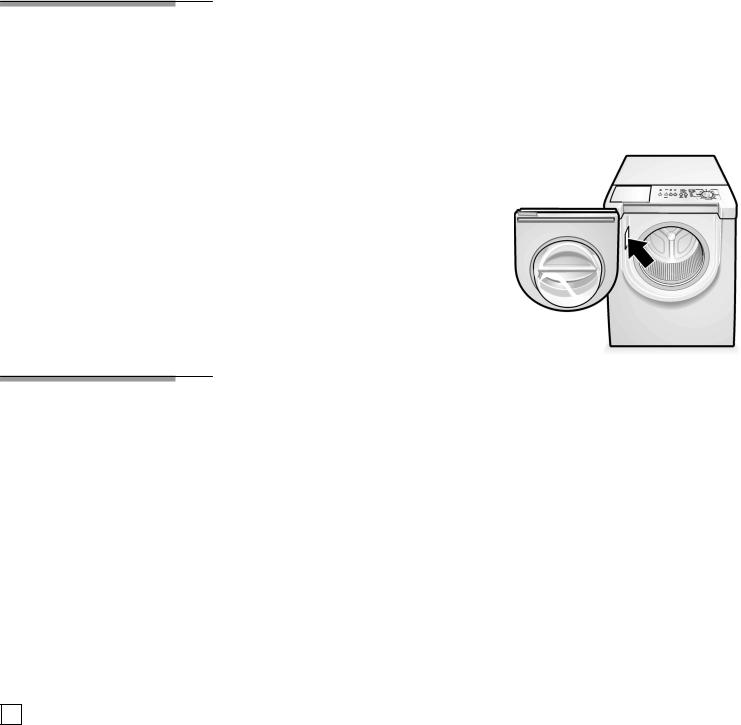
Customer Service
The washing machine requires no special care other than the care and cleaning noted previously. If you are having a problem with your washing machine, please refer to page 22 before calling for service.
If service becomes necessary, contact your dealer or installer or an authorized service center. Do not attempt to repair the appliance yourself. Any work performed by unauthorized personnel may void the warranty.
If you are having a problem with your washing machine and are not pleased with the service you have received:
qFirst, please contact your installer or the Authorized Service Contractor in your area and explain to them why you are not satisfied. This will usually correct the problem.
qIf after working with your installer or service technician the problem still has not been resolved to your satisfaction, please let us know either by writing to us at:
BSH Home Appliances
5551 Mc Fadden Ave. Huntington Beach, CA 92649
or calling us: 1-800-944-2904
If writing or calling, please provide the following information:
-Model Number
-Serial Number
-Date of Original Purchase
-Date Problem occurred
-Explanation of Problem
If writing, please also include a daytime telephone number and a copy of the sales invoice.
You will find the model number and serial number on the rating plate located on the housing and is visible with the door open.
STATEMENT OF LIMITED PRODUCT WARRANTY
What this Warranty covers & Who it Applies to:
The limited warranty provided by BSH Home Appliances ("BOSCH") in this Statement of limited product Warranty applies only to the Bosch DLX washer ("Bosch") sold to you, the first using purchaser, provided that the Product was purchased: (1) for your normal, household (non-commercial) use, and has in fact at all times only been used for normal household purposes: (2) new at retail (not a display, •as is", or previously returned model), and not for resale, or commercial use: and (3) within the United States or Canada, and has at all times remained within the country of original purchase. The warranties stated herein apply only to the first purchaser of the Product and are not transferable.
iPlease make sure to return your
registration card: while not necessary to effectuate warranty coverage, it is the best way for Bosch to notify you in the unlikely event of a safety notice or product recall.
How Long the Warranty Lasts:
Bosch warrants that the Product is free from defects in materials and workmanship for a period of three hundred sixty-five (365) days from the date of purchase. The foregoing timeline begins to run upon the date of
purchase, and shall not be stalled, tolled, extended, or suspended, for any reason whatsoever.
Repair/Replace as Your Exclusive Remedy: During this warranty period, Bosch or one of its authorized service providers will repair your Product without charge to you (subject to certain limitations stated herein) if your Product proves to have been manufactured with a defect in materials or workmanship. If reasonable attempts to repair the Product have been made without success, then Bosch will replace your Product (upgrade models may be available to you, in Bosch's sole discretion, for an additional charge). All removed parts and components shall become the property of Bosch at its sole option. All replaced and/or repaired parts shall assume the identity of the original part for purposes of this warranty and this warranty shall not be extended with respect to such parts. Bosch's sole liability and responsibility hereunder is to repair manufacturer-defective Product only, using a Bosch-authorized service provider during normal business hours.
For safety and property damage concerns, Bosch highly recommends that you do not attempt to repair the Product yourself, or use an un-authorized servicer; Bosch will have no responsibility or liability for repairs or
work performed by a non-authorized servicer. If you choose to have someone other than an authorized service provider service your Product, THIS WARRANTY WILL AUTOMATICALLY BECOME NULL AND VOID. Authorized service providers are those persons or companies that have been specially trained on Bosch products, and who possess, in Bosch's opinion, a superior reputation for customer service and technical ability (note that they are independent entities and are not agents, partners, affiliates or representatives of Bosch). Notwithstanding the foregoing, Bosch will not incur any liability, or have responsibility, for the Product if it is located in a remote area (more than 100 miles from an authorized service provider) or is in a reasonably inaccessible, hazardous, threatening, or treacherous locale, surroundings, or environment; in any such event, if you request, Bosch would still pay for labor and parts and ship the parts to the nearest service provider, but you would still be fully liable and responsible for any travel time or other special charges by the service company, assuming they agree to make the service call.
24
